Experimental Study on the Structural Response of Reinforced Fly Ash-Based Geopolymer Concrete Members
Abstract
1. Introduction
2. Experimental Programme
2.1. Materials Used
- 12 mol./L = X/40/1 L, X = 480 gm (pure), used naoh of 98% purity
- 0.98 X = 480
- X = 489.7 gm
| Sodium silicate | Physical and Chemical Properties | |
| Appearance | colourless | |
| Module by weight SiO2/Na2O | 3.19 | |
| Module by Molecule SiO2/Na2O | 3.3 | |
| Be (at 20 °C) | 39.4 | |
| Na2O (%) | 8.52 | |
| SiO2 (%) | 27.09 | |
| Sodium Hydroxide | Total alkalinity | >990 |
| Na2SO4 (mg/kg) | <80 | |
| Na2CO3 (mg/kg) | <4 | |
| NaCl (mg/kg) | <200 | |
| Fe (mg/kg) | <10 | |
| Cr (mg/kg) | <1 | |
| Pb (mg/kg) | <0.5 | |
| Se (mg/kg) | <5 | |
| Ni (mg/kg) | <2 |
2.2. Reaction Mechanism
2.3. Mix Design
- Fly ash = 350 kg/m3
- Water = 175 kg/m3
- alkaline solution/fly ash = 0.5
- mass of alkaline solution (NaOH + Na2SiO3) = 175 kg/m3
- Na2SiO3/NaOH = 2.5, mass of Na2SiO3 = 125 kg/m3, /NaOH = 50 kg/m3
- Mass of Na2SiO3 solids = solid ratio * total Na2SiO3 = 0.514 * 125 = 64.25 kg/m3
- Mass of NaOH solids = solid ratio * total NaOH = 0.368 * 50 = 18.4 kg/m3
- Needed water = total mass of water–water in alkaline solution
- Needed water = 175–82.65 = 92.35 kg/m3
- Wagg = 1646.24 kg/m3
- Wsand = 0.3 * 1646.24 = 494 kg/m3
- Wgravel = 0.7 * 1646.24 = 1152.36 kg/m3
| Name | LSS/ NaOH | Fly Ash (kg/m3) | Solution | Water Needed (kg/m3) | Sand (kg/m3) | Gravel (kg/m3) | Gravel (kg/m3) | |
|---|---|---|---|---|---|---|---|---|
| NaOH | LSS | 4.76–10 mm | 10–15 mm | |||||
| R0.5F250 | 0.5 | 250 | 83.33 | 41.667 | 72.75 | 581.9 | 678.9 | 678.9 |
| R1F250 | 1 | 62.5 | 62.5 | 69.75 | 581 | 677.8 | 677.8 | |
| R1.5F250 | 1.5 | 50 | 75 | 67.95 | 580.5 | 677.26 | 677.26 | |
| R2F250 | 2 | 41.67 | 83.33 | 66.74 | 580.15 | 676.8 | 676.8 | |
| R2.5F250 | 2.5 | 35.714 | 89.286 | 65.89 | 579.9 | 676.5 | 676.5 | |
| R0.5F300 | 0.5 | 300 | 100 | 50 | 87.3 | 539.3 | 629.18 | 629.18 |
| R1F300 | 1 | 75 | 75 | 83.7 | 538.24 | 627.9 | 627.9 | |
| R1.5F300 | 1.5 | 60 | 90 | 81.54 | 537.6 | 627.21 | 627.21 | |
| R2F300 | 2 | 50 | 100 | 80.1 | 537.19 | 626.7 | 626.7 | |
| R2.5F300 | 2.5 | 42.857 | 107.14 | 79 | 536.89 | 626.3 | 626.3 | |
| R0.5F350 | 0.5 | 350 | 116.67 | 58.33 | 101.8 | 496.6 | 579.4 | 579.4 |
| R1F350 | 1 | 87.5 | 87.5 | 97.65 | 495.45 | 578 | 578 | |
| R1.5F350 | 1.5 | 70 | 105 | 95.13 | 494.7 | 577.17 | 577.17 | |
| R2F350 | 2 | 58.33 | 116.67 | 117.95 | 506.64 | 591 | 591 | |
| R2.5F350 | 2.5 | 50 | 125 | 92.35 | 494 | 576 | 576 | |
| P.C | Cement (kg/m3) | Water (L) | Sand (kg/m3) | Gravel (Kg/m3) 4.76–10 mm | Gravel (kg/m3) 10–15 mm | |||
| 350 | 175 | 567.5 | 662.13 | 662.13 | ||||
2.4. Specimen Details
2.5. Preparation of Geopolymer Concrete
2.6. Test Setup
2.6.1. Beam Test Setup
2.6.2. Slab Test Setup
2.6.3. Column Test Setup
2.7. Mechanical Properties Results
2.7.1. Compressive Strength
2.7.2. Flexural Strength
2.7.3. Splitting Tensile Strength
3. Structural Member’s Response
3.1. Modes of Failure of Tested Beams
3.2. Behaviour of Test Beams
3.3. Mode of Failure of Tested Columns
3.4. Behaviour of Columns
3.5. Mode of Failure of Tested Slabs
3.6. Behaviour of Tested Slabs
4. Conclusions
- The load-deflection curve characteristics of GPC and OPC are nearly identical.
- The cracking behaviour of geopolymer specimens shows that the number of cracks, the cracking region and the cracking space are more prominent in the geopolymer specimens compared with the conventional concrete specimens.
- Fly-ash-based geopolymer concrete members responded similarly to conventional R.C beams exposed to flexural stress (initial cracking load, crack breadth, flexural stiffness, ultimate load).
- The relationship between applied load, deflection and strain for concrete and steel is linear for all tested members before the initial crack load, followed by non-linear behaviour until failure.
- Due to the similarity of structural behaviour of geopolymer concrete and ordinary concrete, such as load-deflection, cracking characteristics, and failure mechanism, geopolymer concrete members may be designed in the same way as conventional concrete.
- Increase in the binder content from 250 to 350 kg/m3 and the Na2SiO3-to-NaOH ratio from 0.5:2.5 consequently increases the compressive strength by nearly 12, 19, and 34%.
- The binder content from 250 to 350 kg/m3 and the Na2SiO3-to-NaOH ratio from 0.5:2.5 consequently leads to an increase in flexural strength by nearly 6, 22, and 35%, but still lower than Portland cement concrete.
- Tensile strength increased by increasing the binder content and the Na2SiO3-to-NaOH ratio by 5, 8, and 27%, but also still lower than Portland cement concrete.
- The optimum mix design to obtain maximum compressive strength, flexural strength and tensile strength occurs at an Na2SiO3-to-NaOH ratio equal to 2.5 and a fly ash content of 350 kg/m3.
- It is preferred to prepare the sodium hydroxide solution immediately before casting so we can benefit from heat released during the preparation process in the curing of geopolymer concrete so it can start curing the geopolymer concrete at ambient temperature and decrease the time and temperature needed for curing it in the oven.
Author Contributions
Funding
Conflicts of Interest
References
- Ali, A.; Yazdani, M.; Hosseini, M.; Akbarzadeh, H.; Farrokh, H. The prediction analysis of compressive strength and electrical resistivity of environmentally friendly concrete incorporating natural zeolite using artificial neural network. Constr. Build. Mater. 2022, 317, 125876. [Google Scholar] [CrossRef]
- García, J.A.; Gómez, J.F.; Castellanos, N.T. Properties prediction of environmentally friendly ultra-high-performance concrete using artificial neural networks. Eur. J. Environ. Civ. Eng. 2020, 26, 2319–2343. [Google Scholar] [CrossRef]
- Naran, J.M.; Eva, R.; Gonzalez, G.; Castillo, R.; Toma, L.; Almesfer, N.; Van Vreden, P.; Saggi, O. Incorporating waste to develop environmentally-friendly concrete mixes. Constr. Build. Mater. 2022, 314, 125599. [Google Scholar] [CrossRef]
- Nwakaire, C.M.; Yap, S.P.; Onn, C.C.; Yuen, C.W.; Ibrahim, H.A. Utilisation of recycled concrete aggregates for sustainable highway pavement applications; a review. Constr. Build. Mater. 2020, 235, 117444. [Google Scholar] [CrossRef]
- Anderson, D.J.; Smith, S.T.; Au, F.T.K. Mechanical properties of concrete utilising waste ceramic as coarse aggregate. Constr. Build. Mater. 2016, 117, 20–28. [Google Scholar] [CrossRef]
- Mohajerani, A.; Burnett, L.; Smith, J.V.; Markovski, S.; Rodwell, G. Resources, Conservation & Recycling Recycling waste rubber tyres in construction materials and associated environmental considerations: A review. Resour. Conserv. Recycl. 2020, 155, 104679. [Google Scholar] [CrossRef]
- Tam, V.W.Y.; Soomro, M.; Catarina, A.; Evangelista, J. A review of recycled aggregate in concrete applications (2000–2017). Constr. Build. Mater. 2018, 172, 272–292. [Google Scholar] [CrossRef]
- Shi, C.; Zheng, K. A review on the use of waste glasses in the production of cement and concrete. Resour. Conserv. Recycl. 2007, 52, 234–247. [Google Scholar] [CrossRef]
- Li, Y.; Zeng, X.; Zhou, J.; Shi, Y.; Abdullahi, H. Development of an eco-friendly ultra-high performance concrete based on waste basalt powder for Sichuan-Tibet Railway. J. Clean. Prod. 2021, 312, 127775. [Google Scholar] [CrossRef]
- Rehan, R.; Nehdi, M. Carbon dioxide emissions and climate change: Policy implications for the cement industry. Environ. Sci. Policy 2012, 8, 105–114. [Google Scholar] [CrossRef]
- Hasanbeigi, A.; Price, L.; Lin, E. Emerging energy-efficiency and CO2 emission-reduction technologies for cement and concrete production: A technical review. Renew. Sustain. Energy Rev. 2012, 16, 6220–6238. [Google Scholar] [CrossRef]
- Amran, Y.H.M.; Alyousef, R.; Alabduljabbar, H.; El-Zeadani, M. Clean production and properties of geopolymer concrete; A review. J. Clean. Prod. 2019, 251, 119679. [Google Scholar] [CrossRef]
- Singh, B.; Ishwarya, G.; Gupta, M.; Bhattacharyya, S.K. Geopolymer concrete: A review of some recent developments. Constr. Build. Mater. 2015, 85, 78–90. [Google Scholar] [CrossRef]
- Ma, C.; Zawawi, A.; Omar, W. Structural and material performance of geopolymer concrete: A review. Constr. Build. Mater. 2018, 186, 90–102. [Google Scholar] [CrossRef]
- Mclellan, B.C.; Williams, R.P.; Lay, J.; Van Riessen, A.; Corder, G.D. Costs and carbon emissions for geopolymer pastes in comparison to ordinary portland cement. J. Clean. Prod. 2011, 19, 1080–1090. [Google Scholar] [CrossRef]
- Hardjito, D.; Wallah, S.E.; Sumajouw, D.M.J.; Rangan, B.V. On the Development of Fly Ash-Based Geopolymer Concrete. Mater. J. 2004, 101, 467–472. [Google Scholar]
- Rangan, B.V. Fly ash-based geopolymer concrete: Study of slender reinforced columns. J. Mater. Sci. 2007, 42, 3124–3130. [Google Scholar] [CrossRef]
- Ramujee, K.; Potharaju, M. ScienceDirect Mechanical Properties of Geopolymer Concrete Composites. Mater. Today Proc. 2017, 4, 2937–2945. [Google Scholar] [CrossRef]
- Tanyildizi, H.; Yonar, Y. Mechanical properties of geopolymer concrete containing polyvinyl alcohol fiber exposed to high temperature. Constr. Build. Mater. 2016, 126, 381–387. [Google Scholar] [CrossRef]
- Patankar, S.V. Mix Design of Fly Ash Based Geopolymer Concrete. In Advances in Structural Engineering; Springer: Berlin/Heidelberg, Germany, 2015. [Google Scholar] [CrossRef]
- Parshwanath, R.N.; Nataraja, M.C. Sulphate resistance and eco-friendliness of geopolymer concretes. Indian Concr. J. 2012, 86, 13. [Google Scholar]
- Aldem, A. Experimental Behaviour of Shear-Critical Beams Produced from Geopolymer Concrete Jeopolimerik Betondan Imal Edilmiş Kesme. Master’s Thesis, Hacettepe University, Ankara, Turkey, 2021. [Google Scholar]
- De Oliveira, L.B.; de Azevedo, A.R.G.; Marvila, M.T.; Pereira, E.C.; Fediuk, R.; Vieira, C.M.F. Durability of geopolymers with industrial waste. Case Stud. Constr. Mater. 2022, 16, e00839. [Google Scholar] [CrossRef]
- Zeyad, A.M.; Magbool, H.M.; Tayeh, B.A.; Garcez de Azevedo, A.R.; Abutaleb, A.; Hussain, Q. Production of geopolymer concrete by utilizing volcanic pumice dust. Case Stud. Constr. Mater. 2022, 16, e00802. [Google Scholar] [CrossRef]
- Ren, J.; Chen, H.; Sun, T.; Song, H.; Wang, M. Flexural Behaviour of Combined FA/GGBFS Geopolymer Concrete Beams after Exposure to Elevated Temperatures. Adv. Mater. Sci. Eng. 2017, 2017, 6854043. [Google Scholar] [CrossRef]
- Maranan, G.B.; Manalo, A.C.; Benmokrane, B.; Karunasena, W.; Mendis, P. Behavior of concentrically loaded geopolymer-concrete circular columns reinforced longitudinally and transversely with GFRP bars. Eng. Struct. 2016, 117, 422–436. [Google Scholar] [CrossRef]
- Arunachelam, N.; Maheswaran, J.; Chellapandian, M.; Murali, G.; Vatin, N.I. Development of High-Strength Geopolymer Concrete Incorporating High-Volume Copper Slag and Micro Silica. Sustainability 2022, 14, 7601. [Google Scholar] [CrossRef]
- Fernández-Jiménez, A. Engineering properties of alkali-activated fly ash. ACI Mater. J. 2006, 103, 106. [Google Scholar]
- Lukey, G.C. Bond performance of reinforcing bars in inorganic polymer concrete (IPC). Adv. Geopolym. Sci. Technol. 2007, 42, 3107–3116. [Google Scholar] [CrossRef]
- Davidovits, J.; Quentin, S. Geopolymers Inorganic polymerie new materials. J. Therm. Anal. Calorim. 1991, 37, 1633–1656. [Google Scholar] [CrossRef]
- Duxson, P.; Fernández-Jiménez, A.; Provis, J.L.; Lukey, G.C.; Palomo, A.; van Deventer, J.S. Geopolymer technology: The current state of the art. J. Mater. Sci. 2007, 42, 2917–2933. [Google Scholar] [CrossRef]
- Verma, M.; Dev, N.; Rahman, I.; Nigam, M.; Ahmed, M.; Mallick, J. Geopolymer Concrete: A Material for Sustainable Development in Indian Geopolymer Concrete: A Material for Sustainable Development in Indian Construction Industries. Crystals 2022, 12, 514. [Google Scholar] [CrossRef]
- ASTM C127-15; Standard Test Method for Relative Density (Specific Gravity) and Absorption of Coarse Aggregate. ASTM International: West Conshohocken, PA, USA, 2015.
- ASTM C128-15; Standard Test Method for Relative Density (Specific Gravity) and Absorption of Fine Aggregate. ASTM International: West Conshohocken, PA, USA, 2015.
- ASTM C150/C150M-21; Standard Specification for Portland Cement. ASTM International: West Conshohocken, PA, USA, 2021.
- ASTM C618-19; Standard Specification for Coal Fly Ash and Raw or Calcined Natural Pozzolan for Use in Concrete. ASTM International: West Conshohocken, PA, USA, 2019.
- Chi, M. Effects of the alkaline solution/binder ratio and curing condition on the mechanical properties of alkali-activated fly ash mortars. J. Sci. Eng. Compos. Mater. 2016, 24, 773–782. [Google Scholar] [CrossRef]
- Kadlag, P.V.; Tushar, S.; Rajguru, D.; Reddy, N.; Engineering, C.; Soet, D.Y.P. Study of Fly Ash Based Geopolymer Concrete with Varying Alkaline Activator Ratio. Int. Res. J. Eng. Technol. 2017, 4, 913–917. [Google Scholar]
- Pane, I.; Imran, I.; Budiono, B. Compressive Strength of Fly ash-based Geopolymer Concrete with a Variable of Sodium Hydroxide (NaOH) Solution Molarity. MATEC Web Conf. 2018, 147, 01004. [Google Scholar]
- ASTM C109; Standard Test Method for Compressive Strength of Cylindrical Concrete Specimens. ASTM International: West Conshohocken, PA, USA, 2021.
- ASTM C496/C496M-17; Standard Test Method for Splitting Tensile Strength of Cylindrical Concrete Specimens. ASTM International: West Conshohocken, PA, USA, 2017.
- ASTM C78/C78M-21; Standard Test Method for Flexural Strength of Concrete (Using Simple Beam with Third-Point Loading). ASTM International: West Conshohocken, PA, USA, 2021.


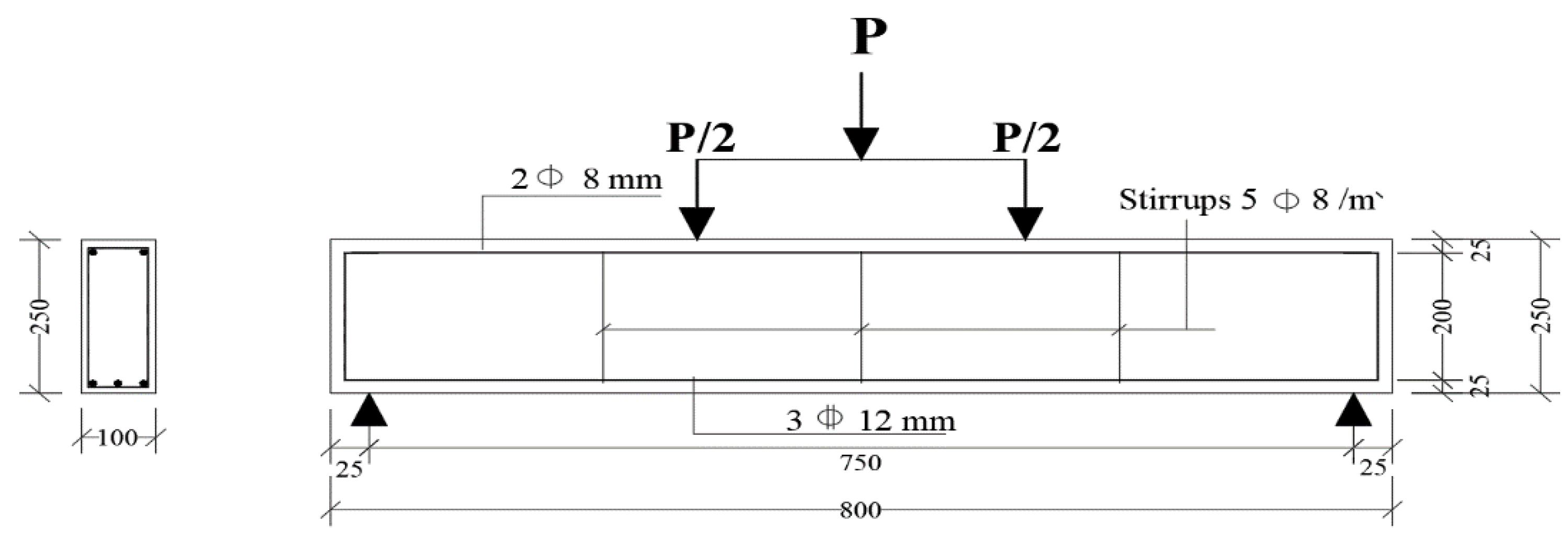








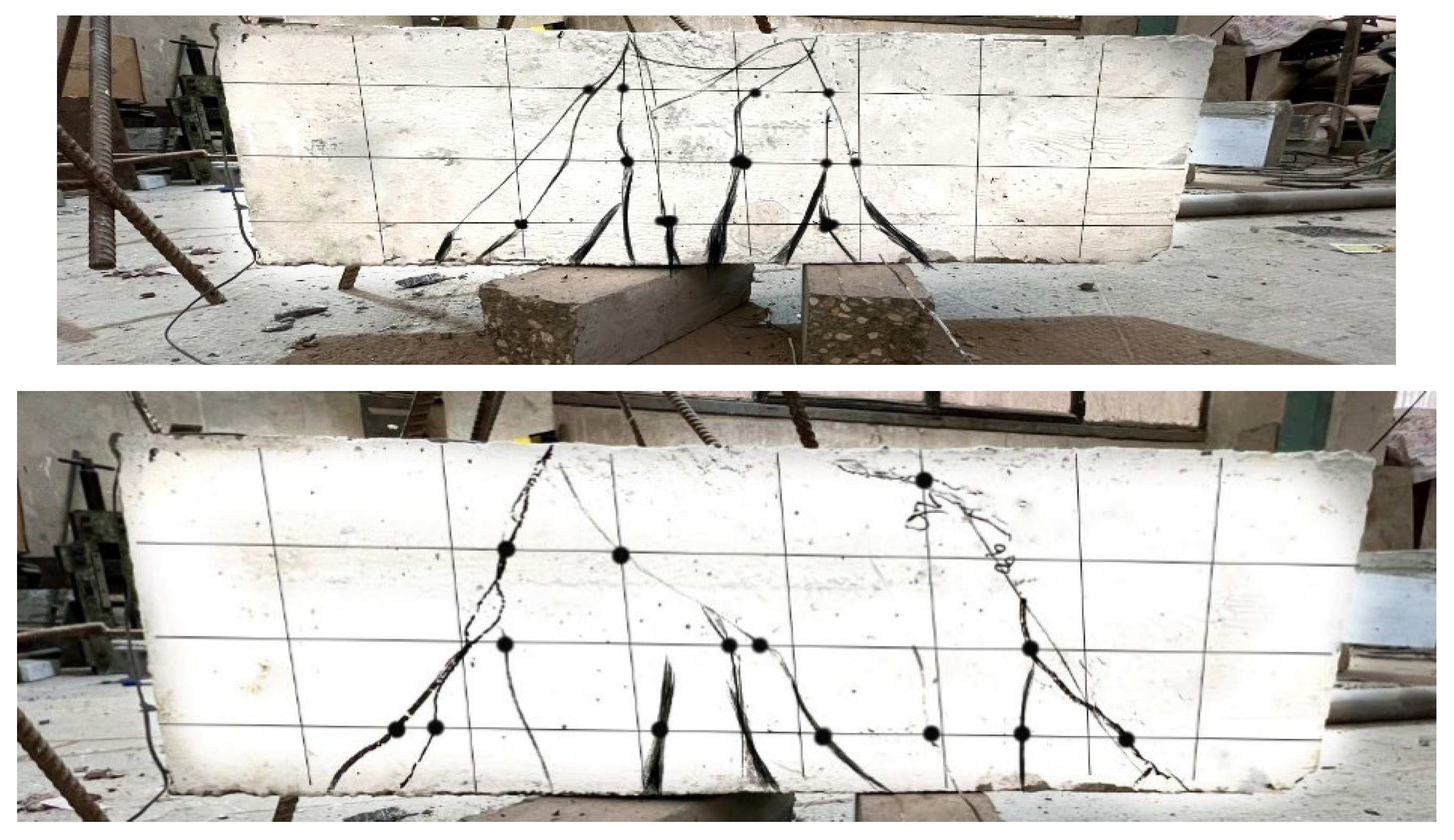






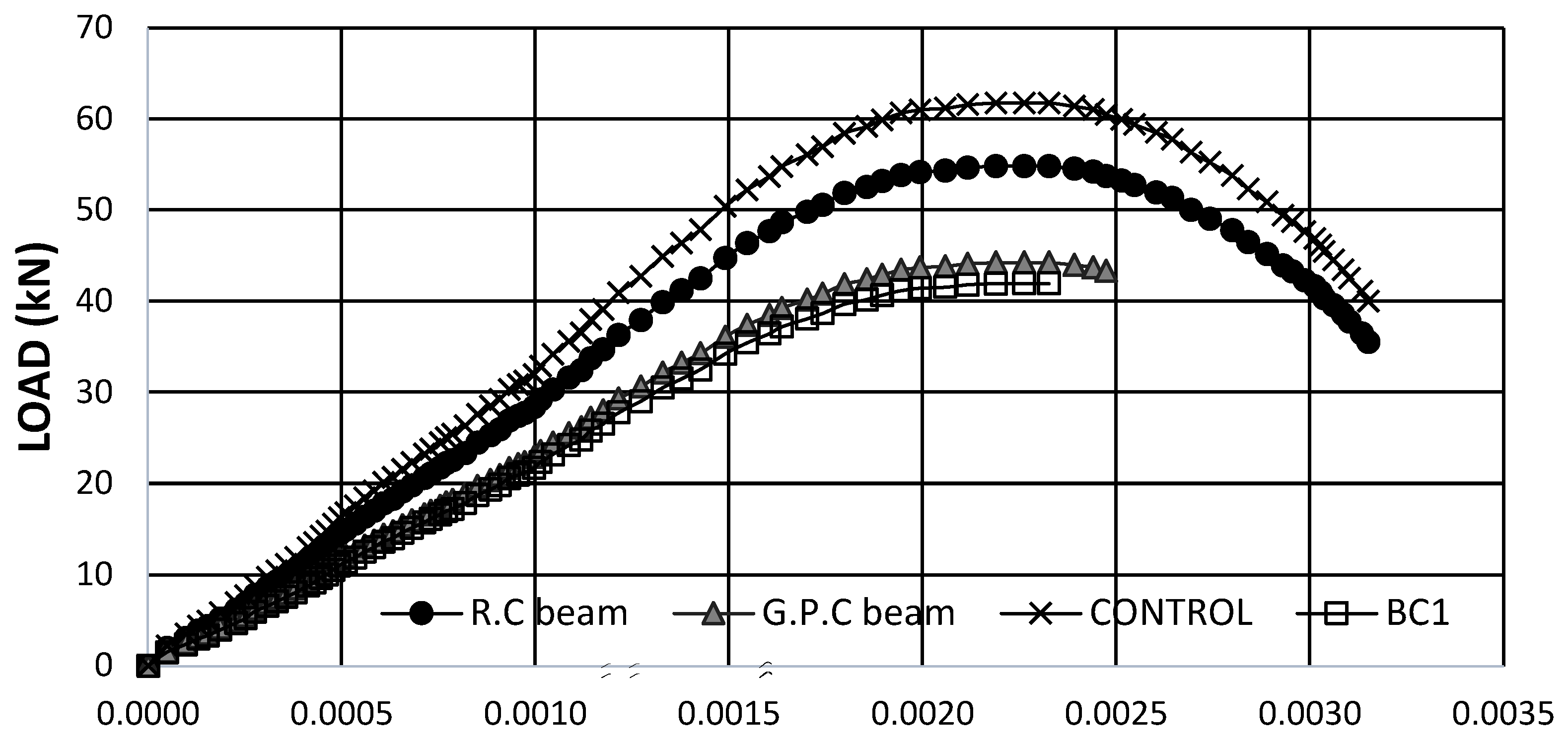

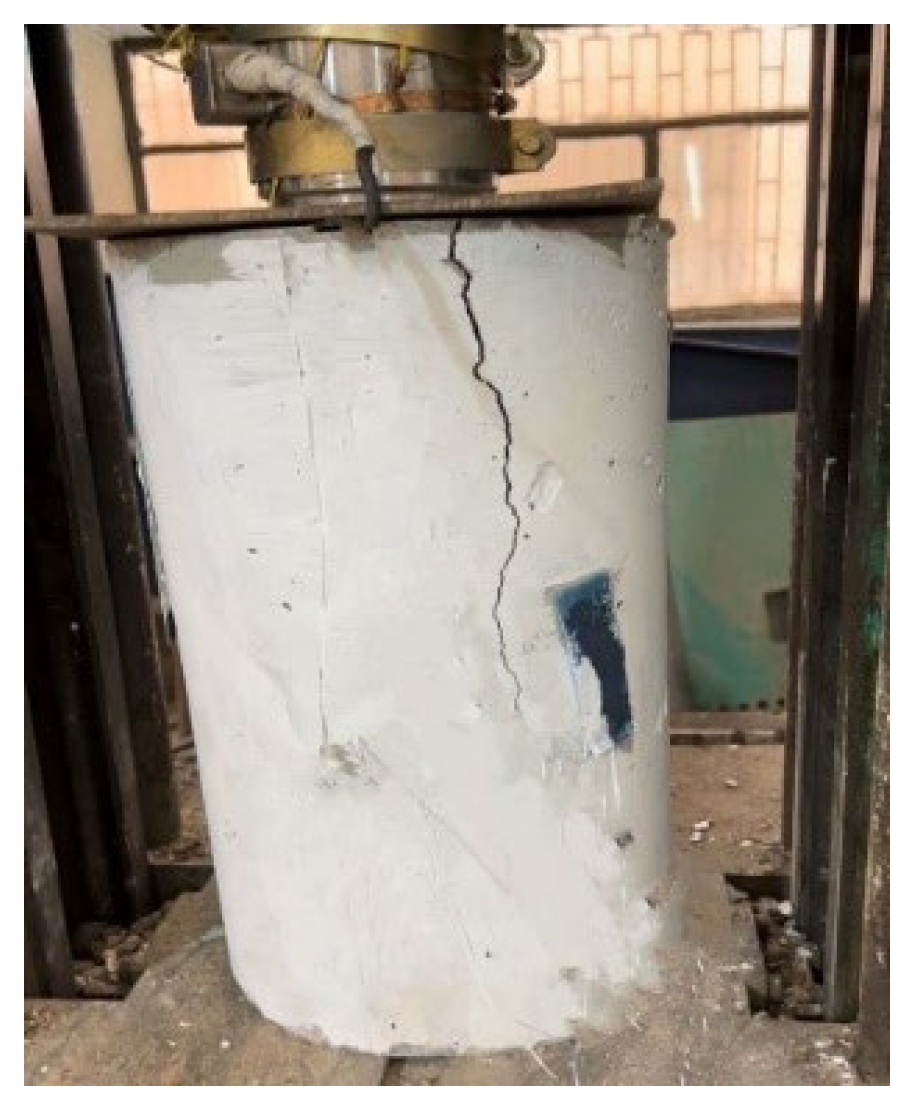
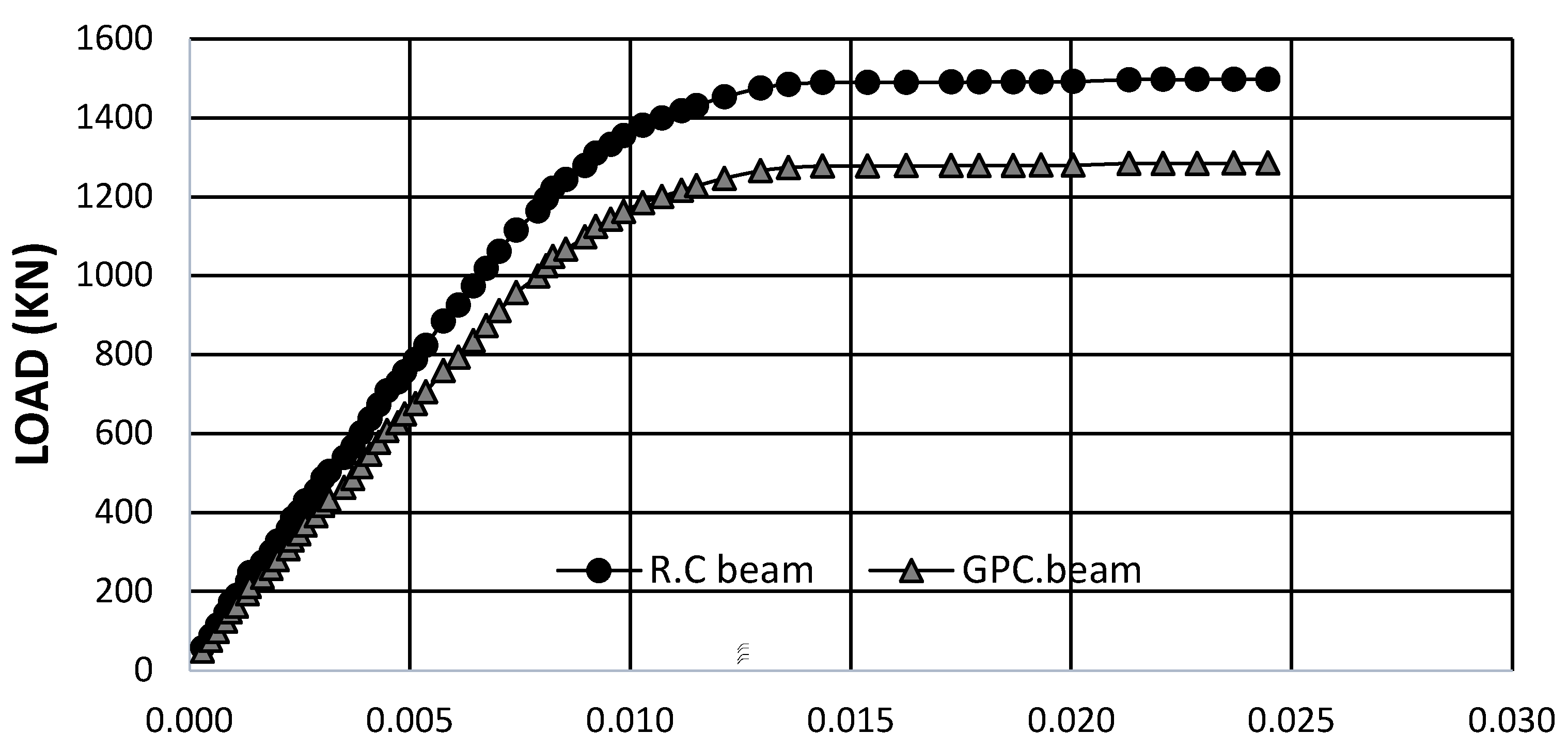

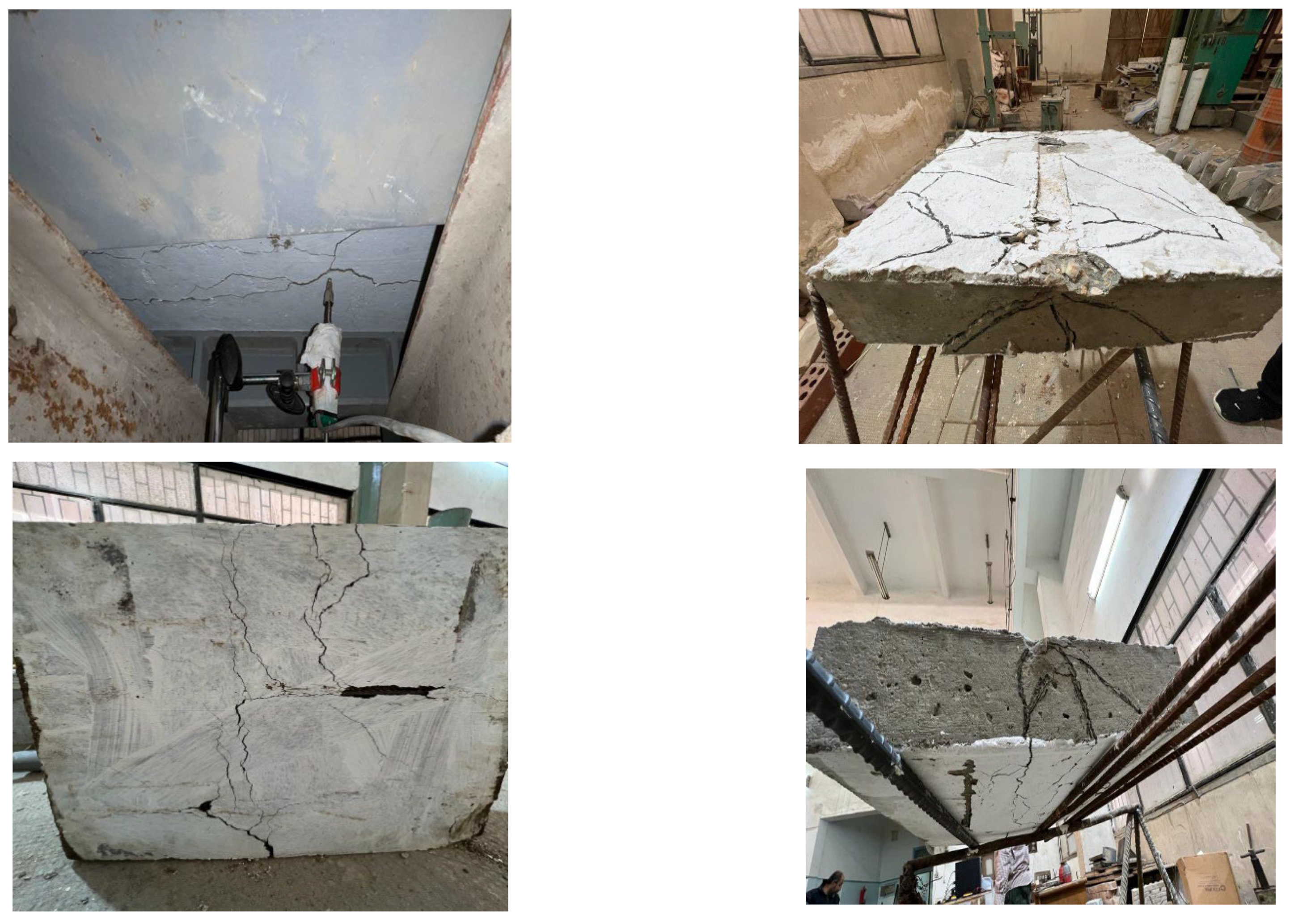



| Fly Ash | Sand | ||
|---|---|---|---|
| Compound. | Measured Value (%) | Property | Value |
| SiO2 | 57.90 | Fineness modulus | 2.56 |
| Fe2O3 | 5.07 | Voids (%) | 38 |
| Al2O3 | 31.11 | Dry volume weight (t/m3) | 1.66 |
| Cao | 1.29 | Specific gravity | 2.65 |
| MgO | 0.97 | Clay and fine dust content | 1.4 |
| SO3 | 0.05 | ||
| Na2O | 0.09 | ||
| K2O | 1.00 | ||
| LOI | 0.80 | ||
| CL | 0.04 | ||
| Elements. | ID | Cross-Section | Main Steel | Stirrups Hanger | Stirrups | |
|---|---|---|---|---|---|---|
| Beams | G.P.C beams | G. Beam (1) | 100 × 250 × 800 | 2Ø10 | 2Ø8 | Ø8 @ 100 mm |
| G. Beam (2) | 100 × 250 × 800 | 2Ø10 | 2Ø8 | Ø8 @ 100 mm | ||
| G. Beam (3) | 100 × 250 × 800 | 2Ø10 | 2Ø8 | Ø8 @ 100 mm | ||
| G. Beam (4) | 100 × 250 × 800 | 3Ø12 | 2Ø8 | Ø8 @ 200 mm | ||
| G. Beam (5) | 100 × 250 × 800 | 3Ø12 | 2Ø8 | Ø8 @ 200 mm | ||
| G. Beam (6) | 100 × 250 × 800 | 3Ø12 | 2Ø8 | Ø8 @ 200 mm | ||
| R.C beams | RC. Beam (1) | 100 × 250 × 800 | 2Ø10 | 2Ø8 | Ø8 @ 100 mm | |
| RC. Beam (2) | 100 × 250 × 800 | 2Ø10 | 2Ø8 | Ø8 @ 100 mm | ||
| RC. Beam (3) | 100 × 250 × 800 | 2Ø10 | 2Ø8 | Ø8 @ 100 mm | ||
| RC. Beam (4) | 100 × 250 × 800 | 3Ø12 | 2Ø8 | Ø8 @ 200 mm | ||
| RC. Beam (5) | 100 × 250 × 800 | 3Ø12 | 2Ø8 | Ø8 @ 200 mm | ||
| RC. Beam (6) | 100 × 250 × 800 | 3Ø12 | 2Ø8 | Ø8 @ 200 mm | ||
| Cross-section | Main Steel | |||||
| Slabs | G.P.C slabs | G.Slab (1) | 500 × 500 × 100 | 5 Ø10/m | ||
| G.Slab (2) | 500 × 500 × 100 | 5 Ø10/m | ||||
| G.Slab (3) | 500 × 500 × 100 | 5 Ø10/m | ||||
| R.C slabs | RC.Slab (1) | 500 × 500 × 100 | 5 Ø10/m | |||
| RC.Slab (2) | 500 × 500 × 100 | 5 Ø10/m | ||||
| RC.Slab (3) | 500 × 500 × 100 | 5 Ø10/m | ||||
| Diameter | Depth | Stirrups | Main Steel | |||
| COLUMNS | G.P.C column | G. col. (1) | 350 mm | 700 mm | Ø8@200 mm | 9Ø12 |
| G. col. (2) | 350 mm | 700 mm | Ø8@200 mm | 9Ø12 | ||
| G. col. (3) | 350 mm | 700 mm | Ø8@200 mm | 9Ø12 | ||
| RC. column | RC.col. (1) | 350 mm | 700 mm | Ø8@200 mm | 9Ø12 | |
| RC.col. (2) | 350 mm | 700 mm | Ø8@200 mm | 9Ø12 | ||
| RC.col. (3) | 350 mm | 700 mm | Ø8@200 mm | 9Ø12 | ||
| Group | Name Mixture | FLY ASH Content | LSS/ NaoH | Flexural Strength (MPa) | Compressive Strength (MPa) 7 Days | Compressive Strength (MPa) 28 Days | Tensile Strength (MPa) |
|---|---|---|---|---|---|---|---|
| Group (1) | R0.5F250 | 250 | 0.5 | 4.05 | 18.0 | 26.0 | 2.47 |
| R1F250 | 250 | 1.0 | 4.36 | 19.5 | 28.0 | 2.56 | |
| R1.5F250 | 250 | 1.5 | 4.12 | 20.5 | 26.0 | 2.31 | |
| R2F250 | 250 | 2.0 | 4.29 | 25.0 | 27.5 | 2.61 | |
| R2.5F250 | 250 | 2.5 | 5.13 | 23.0 | 32.0 | 3.04 | |
| Group (2) | R0.5F300 | 300 | 0.5 | 4.62 | 21.0 | 30.0 | 2.85 |
| R1F300 | 300 | 1.0 | 5.83 | 20.5 | 32.0 | 3.13 | |
| R1.5F300 | 300 | 1.5 | 6.47 | 24.0 | 35.0 | 3.32 | |
| R2F300 | 300 | 2.0 | 5.52 | 23.5 | 30.0 | 2.85 | |
| R2.5F300 | 300 | 2.5 | 6.39 | 20.0 | 34.0 | 3.27 | |
| Group (3) | R0.5F350 | 350 | 0.5 | 6.76 | 24.0 | 36.0 | 3.44 |
| R1F350 | 350 | 1.0 | 6.20 | 22.5 | 33.0 | 3.14 | |
| R1.5F350 | 350 | 1.5 | 6.39 | 22.5 | 34.0 | 3.21 | |
| R2F350 | 350 | 2.0 | 6.01 | 25.0 | 35.0 | 3.30 | |
| R2.5F350 | 350 | 2.5 | 7.03 | 26.0 | 37.0 | 3.63 | |
| P.C | - | - | 8.49 | 22.0 | 34.5 | 4.32 |
| Group | Name SP | Crack Load KN | Ultimate Load KN | Ultimate Elongation | Type Failure |
|---|---|---|---|---|---|
| Group A | R.C B (1) | 45 | 63 | 0.0036 | Flexural failure |
| R.C B (2) | 43 | 56 | 0.0029 | Flexural failure | |
| R.C B (3) | 47 | 61 | 0.0032 | Flexural failure | |
| GPC B (1) | 37 | 54 | 0.0026 | Flexural failure | |
| GPC B (2) | 32 | 53 | 0.0023 | Flexural failure | |
| GPC B (3) | 33 | 58 | 0.0027 | Flexural failure | |
| Group B | RC.B (1) | 47 | 66 | 0.0033 | Shear failure |
| RC.B (2) | 51 | 68 | 0.0034 | Shear failure | |
| RC.B (3) | 49 | 63 | 0.0026 | Shear failure | |
| GPC B (1) | 36 | 48 | 0.0024 | Shear failure | |
| GPC B (2) | 37 | 43 | 0.0019 | Shear failure | |
| GPC B (3) | 40 | 53 | 0.0027 | Shear failure |
Publisher’s Note: MDPI stays neutral with regard to jurisdictional claims in published maps and institutional affiliations. |
© 2022 by the authors. Licensee MDPI, Basel, Switzerland. This article is an open access article distributed under the terms and conditions of the Creative Commons Attribution (CC BY) license (https://creativecommons.org/licenses/by/4.0/).
Share and Cite
Eisa, A.S.; Sabol, P.; Khamis, K.M.; Attia, A.A. Experimental Study on the Structural Response of Reinforced Fly Ash-Based Geopolymer Concrete Members. Infrastructures 2022, 7, 170. https://doi.org/10.3390/infrastructures7120170
Eisa AS, Sabol P, Khamis KM, Attia AA. Experimental Study on the Structural Response of Reinforced Fly Ash-Based Geopolymer Concrete Members. Infrastructures. 2022; 7(12):170. https://doi.org/10.3390/infrastructures7120170
Chicago/Turabian StyleEisa, Ahmed S., Peter Sabol, Kamilia M. Khamis, and Ahmed A. Attia. 2022. "Experimental Study on the Structural Response of Reinforced Fly Ash-Based Geopolymer Concrete Members" Infrastructures 7, no. 12: 170. https://doi.org/10.3390/infrastructures7120170
APA StyleEisa, A. S., Sabol, P., Khamis, K. M., & Attia, A. A. (2022). Experimental Study on the Structural Response of Reinforced Fly Ash-Based Geopolymer Concrete Members. Infrastructures, 7(12), 170. https://doi.org/10.3390/infrastructures7120170







